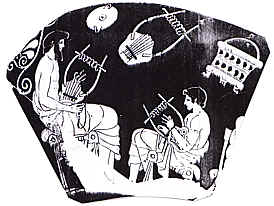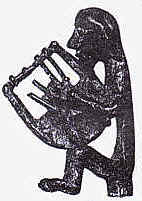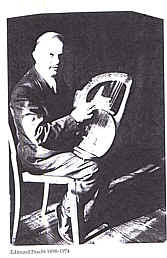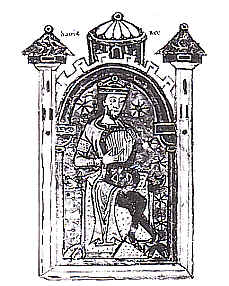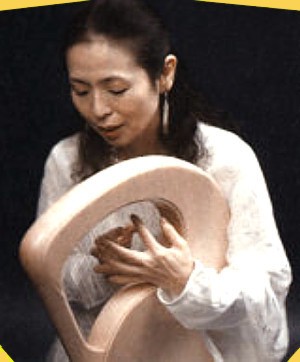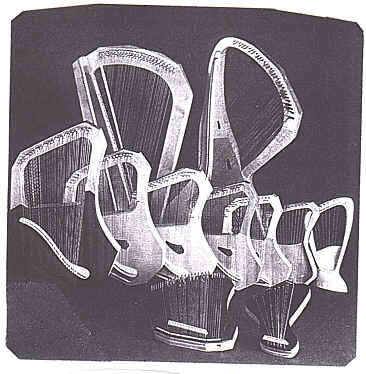We
have all heard
sometimes of the lyre. An ancient instrument, ej. the
Celtic lyre or the
Lyra
of the Greeks, also known as the kithara (= root of the word
“guitarra -guitar). The authors of the antiquity, such as Plato,
tell about how the sound of the lyre at the mystery plays, contributed,
changing and enchanting people. An almost a magical effect – in a
positive way – is ascribed to it. in many old legends and mythologies.
The harmonising effect its sound produces did not only change humans, but
also animals and mythological beings. As
told of the legendary Orpheus: as he went down to the underworld in search
of Euridice. who was someone
like a soul mate to him. He enchanted everybody he encountered.
“Persephone is overcome from his chant. The Erynnien, the four judges of
death, weep, Cerberus, the dog of hell becomes tame, the Parcae pick the
thread of life up again, Charon leaves his boat and comes to listen. The
shadows of the dead crowd around the holy singer, the penitents forget
their suffering, the tormentors leave them alone, as long as Orpheus sings.
Into the world of death a soft air blows a breath of life."(Karl von
Baltz). Another
myth tells how Amphion, a son of Zeus and founder of Theben, played on
Ù
Also
in the care of the aged, and in the assistance to dying persons,
the lyre has shown its comforting harmonious effect. Parallel to this development over the years appeared, according to the use, a rich music literature for the lyre. Next to adaptation of known masterpieces from the music literature so far as they were suited for the lyre - specific works were written for lyre ensembles, lyre choruses, for virtuoso soloist performances, lyre accompaniments for singers, pieces for the lyre and other instruments, for puppet theatre, for the celebrations as the seasons change and for the renewed services at the "Christian Community" Ù
At
the kindergarten age and during the first two primary school years we
recommend the Pentatonic tuning, music applied in the Waldorf pedagogy.
There are no halftones as in the major- and minor- scales. Instead the
music has a mobile, an associative ductus. For this aim, special
pentatonic lyres were build, best suited for the child of this age
and to get it to listen with attention One
teacher at a elementary school
tells us about a successful storytelling hour.
A gnome lives in a little cave, near a lake, orders the spiders to
make him a net and goes to hunt with it.
First he catches a little goldfish, puts him in a glass of
water and keeps him in his cave. The raven manages to rescue the poor
fish. The next victim is a butterfly and then he catches a frog with a
lasso that he made with hair from his whiskers.
Granny Morla lives near the lake. She sees all the injustices the
gnome does and wants to put a stop to his deeds. Granny Morla goes
with her backpack to the lake, hides among some bushes, takes the
magic instrument out of her knapsack and starts to play” As I go on
telling, - explains the
teacher - I take the lyre from its case, unwrap it and start to play
and sing. The delicate sound from the instrument has an almost
magical character. The children listen with the greatest attention.
How long the impression persists in the children’s mind shows from
the remark of a very unruly child. At the end of the weekly talk, he
said, “I liked the magic music best “. Another normally very
unattentive child gave me a crayon drawing in which the lyres had a
preferential place.
Children blossom with experience. Experiences
are in this context things that are felt, experienced and verbally
expressed. It is to be hoped that more teachers find the courage to
sing, play and make music at the classroom and put a greater range of
tone, moods and vibrations into the formation and education process,
than normally indicated or compulsory.(The story was extracted from
the book “Liputto” by Jakob
Streit, Ed. Urachhaus)
Ù Let
us listen to the report of the
experience of a teacher (Switzerland).
“It
was an unsettled day, the children came unruly and fighting from the
recess. Due to a meeting I was late. The revolution in the classroom
could be heard from far away. How to calm down those excited children?
With some commanding gestures I ordered the children to their places.
One child sat under the teacher’s desk. Without hurrying I took the
lyre from its case, sat down on a chair and started to play.
Immediately there was calm, harmony and thoughtfulness. Even the girl
under the desk, who was dreaded as a wild fighter, returned happily to
her place. This calm and internal order lasted almost half an hour
during which the children were busy, devoted themselves to drawing
with crayons: The king as he walked over the mysterious bridge was
playing and singing in the calm of the late afternoon. Meanwhile the
dragon slept under the bridge.” A female pedagogue from a boarding school reports: In my group I have got a ten year old boy, who from time to time is very unsettled and distracted. He then does very silly things and afterwards he cannot explain why he did them in the first place. Of course this is very irritating. So I have begun to play the lyre with him: three times a week, after which he is always completely changed. A completely different spirit appears in the child. Ù
Children
undergoing health therapy usually cannot manage the instruments used at
school. Even the Orff instruments are not appropriate. The sound of the lyre
nevertheless gets the attention of these cared for children. How can we
understand this? The secret of the lyre lies in its floating tones, they
remain a little longer in the air and the chords do not end abruptly, as in
most instruments. From a such great assortments of lyres, differentiated in
tone and tone volume, a suitable lyre can be found even for a very weak or
frail child, with which it can, in its own free or guided play, live to
enjoy music. I myself could see very satisfied and overjoyed handicapped
children, after they were permitted to accompany a choir on Bordun lyres. To
get this accompaniment three Bordun lyres were tuned each in one of three
different tones (Tonic, Subdominant and Dominant) and three children only
had at some special parts of the song - the teachers helps with a gesture
– to let their hand glide
over the strings and produce the harmonic sound. You could see how satisfied
they where, to accomplish such an important task well. Ù
A
music therapist tells about the harmonising effect of the lyre with
children requiring special care for the soul. One six year old boy had difficulty
in getting to sleep. Even with lyre melodies the therapist did not
achieve much the boy only mimicked the melodies some what forced, or he
went ahead of them. But as soon as he himself played the situation
changed. Fully absorbed, he listened to the flowing sound, his breathing
calmed, became regular and deeper and in no time he was asleep.
Everybody who has worked in therapy knows the distressing
problems with spastic paralyzed children: We observed a clear relaxation of the
tensed muscles, when we made them listen to lyre sounds.
One six year old boy, who sometimes was victim to extreme
unsettled periods gave proof of
the healing strength of the
lyre. His bouts could be life threatening because his circulatory
system became so weak. A great help, at the beginning of the bout was
the action of the therapist. He put the child with his back on a big
Tenor lyre, with deep tuning. Then he started to play with even
movements, building chord from deep to higher tones. Later he did the
same from high to deeper chords to the deepest one. Those lyres, with
their deep resonance produced pleasant, easy to feel vibrations in the
child and the calming
effect was almost immediate.( For details of this
report and other therapeutic and pedagogic results, please see
www.leier.de.
The aforementioned stories about the effects of the lyre seem so fantastic,
that we commonly relegate them to the region of mythology, without thinking
any more about the message in the illustrations. But if we suspect with good
reason that people from ancient cultures and ways of life were much more
permeable to musical sounds, the almost magical effect of the lyre becomes
more understandable. People of our day cannot be seen as permeable any more;
we are permanently invaded, against our will, with “acoustic electronic
stimulus”. We do not come to have a deep, vivid internal feeling of music
any more. so I do not like to call it music. One tends to ask, can a machine
really make music? Where is the player who in a given situation makes music
for the audience?
Could it be that the sign that the lyre has had such an extraordinary
diffusion since its re birth is because a resurgent feeling for real, living
and not manipulated musical sounds, will appear and will need special care? Ù
An antique musical instrument has been awakened to new life, to enrich
the soul.
The modern methods of instrument building, combined with centuries of
experience in the building of stringed instruments, generated a very
renovated impulse to culture.
Beyond the ample use of the lyre in psychic treatment and health pedagogy,
other luthiers have taken this impulse, modified it on their own and
developed it further. Their intention has been the search to obtain new
sounds, which in their character could not be achieved with classical
instruments. In the mean time we have an ample spectrum of different types
of lyres starting with the small 7 string pentatonic lyres, to the
children’s lyres, big and small Soprano , Solo Soprano, big
and small Contralto,
Tenor, Bass, Bordun, and also a
54 string big standing lyre. like a harp
Ù Ù Ù Ù Ù Ù Ù Ù Ù links:
home
about us
our products
quality and sound
accessories
+ pricesa |
||||||||||||||||||||||||||||||||||||||
